Business intelligence software Wikipedia
Content
Once the data is collected, it needs to be stored in a central repository for easy access and retrieval. Data warehouses like Snowflake, BigQuery, or Redshift; or data lakes like Databricks, are commonly used for this purpose. These repositories are designed to handle large volumes of data and often scale by separating compute and storage layers. The complexity stems from data diversity, the need https://www.xcritical.com/ for real-time updates, handling high data volumes, and maintaining data integrity and security. A well-implemented data warehouse can significantly enhance a company’s efficiency, productivity, and overall competitive advantage. Business intelligence software is a kind of application software that runs everything we described above.
Data collection from various sources:
Molded into digestible, thematically related chunks of information (if you go with OLAP cubes or data marts), data is finally presented via a user interface of BI tools. In the past, business intelligence could produce only static reports, based on future and past events. Today, BI is capable of producing interactive dashboards and visualizations with customizable portions of information. Digital wallet Ad hoc reporting allows users to quickly generate reports on an as-needed basis to get the answer to a specific question (e.g., “How did our hotel’s RevPAR change over the last month?”). Sigma is a robust example of business intelligence software that enables data democratization by offering cloud-native and collaborative data exploration. It allows users, regardless of their technical skill level, to analyze large volumes of data and derive actionable insights to inform strategic decision-making.
Microsoft partners with industry leaders to offer vertical SLMs
Needless to say, if you work in sales, BI is a critical component to your success. All this information is integrated through BI systems to arrive at a comprehensive view of a business and help it make actionable and improved decisions. By contrast, AI tools are built to model human intelligence in the business intelligence in trading form of rational decision-making. For example, in certain instances, an AI chatbot can replace customer service reps. While it doesn’t necessarily improve customer relationships, it can fill the real-time gap for simple questions or concerns. Business intelligence is an umbrella term that includes best practices, software, infrastructure and other tools to optimize decision-making and enhance a business’s performance.
Self-service reporting for operational applications

By leveraging these tools, businesses can gain a deeper understanding of their performance, customers, and market, which can inform strategic decisions and foster a competitive advantage. As companies work to expand their BI capabilities, security and privacy will become even more important. Ensuring the privacy, integrity, and security of growing amounts of data will become paramount.
BI begins with the collection of data from various internal and external sources, including databases, spreadsheets, enterprise systems like ERP or CRM, social media, and customer feedback. The data, whether structured or unstructured, is then integrated into a centralized repository and stored in a data warehouse. For example, a retail company might gather sales data from its point-of-sale systems, inventory data from its warehouse management system, and customer data from its CRM system. This integrated data is analyzed using BI tools to uncover insights such as purchasing patterns, product performance, and customer demographics.
Understand what happened and why, what might happen, and what you can do about it. With clear, step-by-step explanations of its reasoning, Project Ripasso empowers every business user with insights for confident decision-making at the speed of thought. A project or project management dashboard displays data on the status and progress of business efforts. Project managers use them to track tasks, deadlines, costs and other parameters that aid in monitoring work, spotting problems and keeping projects on schedule and budget. Once you’re set up and running, remember to assure the quality of the developed infrastructure and reports you generate.
In some cases, members of a BI team design the dashboards; in others, business analysts and other users create them using self-service BI tools. Traditional BI analyses are often based on historical data and can be time-consuming. With AI and ML, businesses can analyze data in real-time, enabling instantaneous decision-making based on current data. This can be particularly useful in rapidly-changing industries where real-time data can provide a competitive edge. This process is typically carried out by data analysts, data scientists, or designated data cleaning specialists within an organization.
Business analytics (BA) is then a subset of BI, with business analytics providing the prescriptive, forward-looking analysis. It is the umbrella of BI infrastructure that includes the tools for the identification and storage of the data for decision-making. One of the early BI technologies, OLAP tools enable users to analyze data along multiple dimensions, which is particularly suited to complex queries and calculations. In the past, the data had to be extracted from a data warehouse and stored in multidimensional OLAP cubes, but it’s increasingly possible to run OLAP analyses directly against columnar databases. The service is scalable, allowing it to work with big data or small corporate databases.
- Our credible Business Intelligence (BI) services work as a compass, guiding you toward smarter, more profitable decisions.
- You want a smart solution that lets you quickly and easily search for what you need and get to the data directly—one that allows you ask questions and receive answers in human language rather than code.
- With BA, you can anticipate developments and make the changes necessary to succeed.
- Additionally, the Natural Language Insights object has been updated for better functionality and insights, with native support for all Qlik Cloud features.
- BI is a core business value; it’s difficult to find a business area that doesn’t benefit from better information to work with.
While the reports described above provide detailed application information for daily tactical decisions by line managers and shop floor users, they may not suit executives or line of business managers. Executives may not need operational applications daily, but instead weekly, daily, or hourly snapshots of business performance and process tracking. A business intelligence performance dashboard measures short- and long-term trends with quick access to underlying details to help managers react based on KPIs and highly graphical metrics. Traditional business intelligence is still a common approach for regular reporting and answering static queries. While IT departments are still an important part of managing access to data, multiple levels of users can customize dashboards and create reports on little notice. With the proper software, users are empowered to visualize data and answer their own questions.
Its array of functionalities for data exploration, reporting, and collaborative work makes it a popular choice for data teams, analysts, and data-driven professionals. With Mode, you can build data models, connect to diverse data sources, schedule reports, and perform advanced analytics using Python, R, and SQL. Speaking of scale, it’s vital to invest in a tool that is going to grow with your business. You don’t want to spend time and energy setting up and exposing your users to one business intelligence tool only to outgrow it as your business and data needs change. Look for a tool that can handle large amounts of data without lagging and sacrificing the user experience. When data is visualized, key performance indicators and business metrics are much easier to understand.
Qlik Sense is particularly adept in offering a fully interactive mobile BI experience, enabling users to explore data, generate insights, and collaborate on-the-go with optimized apps for both tablets and smartphones. Open-source BI tools and scalable Software as a Service (SaaS) solutions have democratized access to BI technologies. While self-service tools have reduced the dependency on data science expertise, having a robust understanding of these platforms is beneficial in maximizing their potential. IMD offers digital transformation curricula that delve into BI among other digital technologies.
The process of BI adoption can be broken down into the introduction of business intelligence as a concept for your company employees and the actual integration of tools and applications. The ETL (Extract, Transform, Load) or data integration tools will preprocess raw data from the initial sources and send it to a warehouse in three consecutive steps. In the modern business world, the challenges in BI and analytics can be as diverse as the data they analyze. From coping with the big data tsunami to ensuring data quality and integrating Self-Service Business Intelligence into the existing data warehouse, it is a constant juggling act. The rapid development in the BI and analytics landscape in particular can make it difficult to keep up.
Interactive (clickable) data visualizations support drilling down to explore details, identify patterns and outliers, and change which data is processed and/or excluded. When data is visualized, it’s easier to identify emerging trends, the very first step in deriving insight. Mobile BI solutions are available with voice-enabled access and real-time alerts.

Look for an all-in-one BI solution that can house all of the necessary tools, or find a third-party data connector to make sense of the various information you gather from different BI tools. Over time, they offer a return on investment, but usually not within the first year. If cost is a concern, consider using self-service BI tools, which do not require IT support for onboarding or minor adjustments. Although BI tools offer many benefits, they’re not always easy to implement, especially for small businesses. By connecting phone records, text data from live chats, and prior purchases, you can use data history to offer excellent customer service. In a September 2024 product update, Zoho Analytics added a variety of new features including unified metrics to eliminate duplication, audit and sync history for data import, and multi-server architecture.
